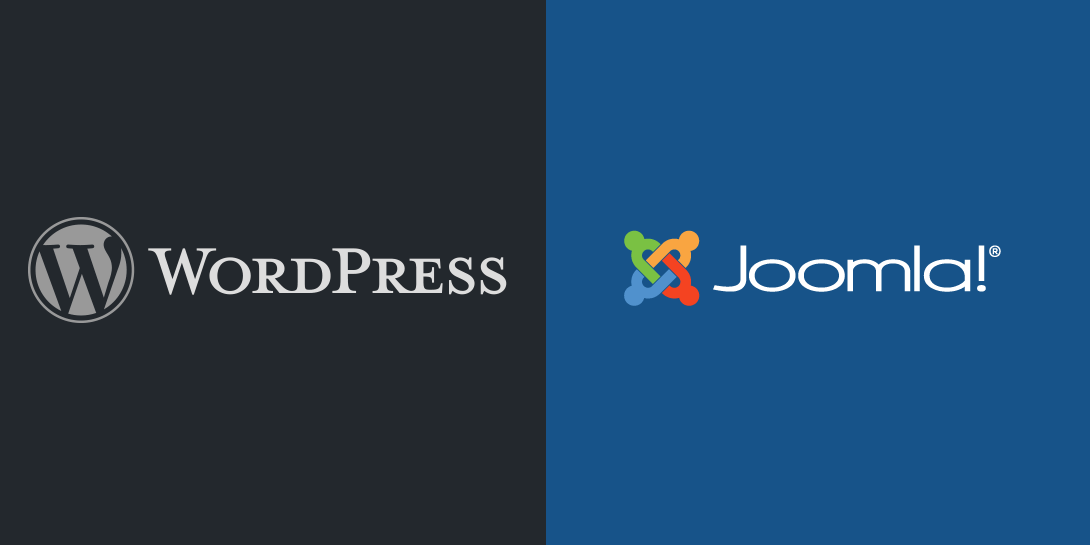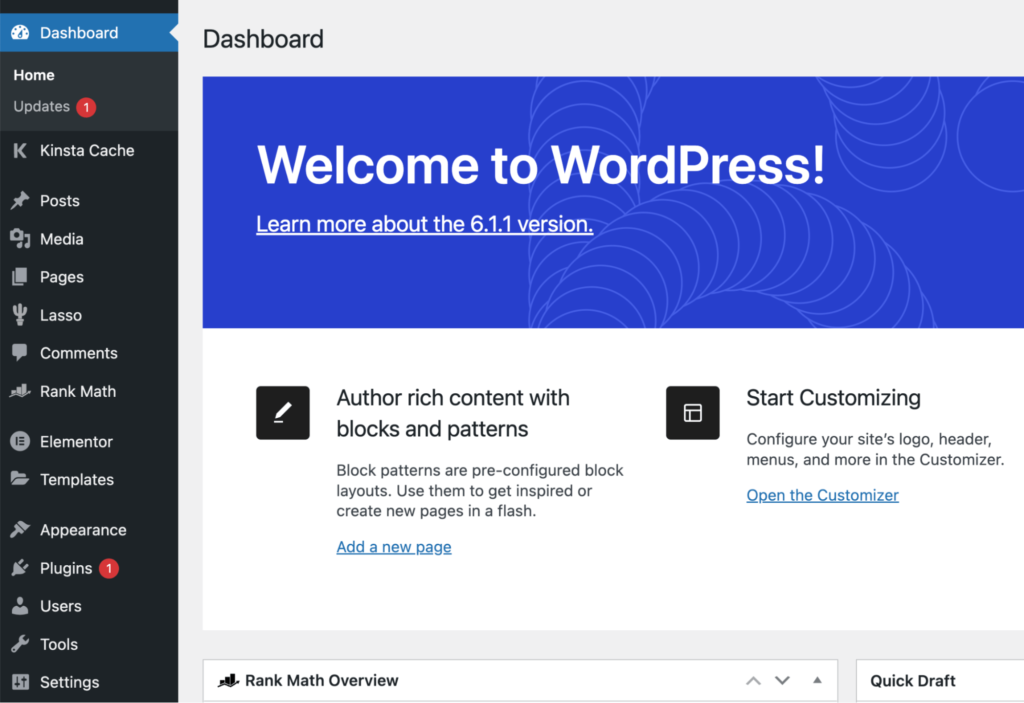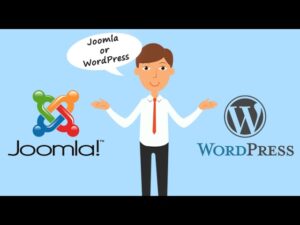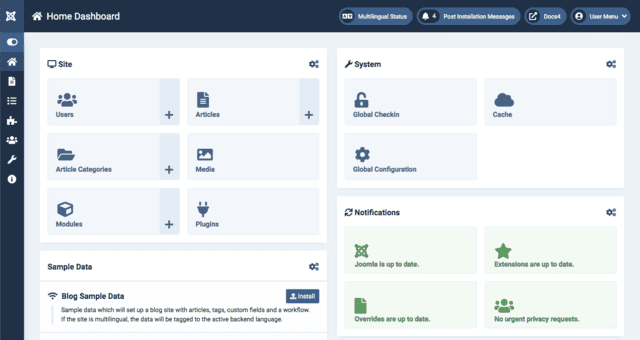
WordPress or Joomla which one to choose ?
WordPress and Joomla are both popular content management systems (CMS) that enable users to build and manage websites without extensive coding knowledge. Let’s delve into each of them:
WordPress:
Overview: WordPress is a highly versatile and user-friendly open-source CMS. Originally developed as a blogging platform, it has evolved into a powerful tool for creating a wide range of websites, from simple blogs to complex e-commerce sites and corporate pages.
Key Features:
- User-Friendly Interface: WordPress boasts an intuitive and user-friendly interface, making it accessible for individuals with varying levels of technical expertise.
- Themes and Plugins: The availability of a vast array of themes and plugins allows users to customize the appearance and functionality of their websites easily.
- Community Support: Being an open-source platform, WordPress has a large and active community. This means users can find support through forums, documentation, and various online resources.
Use Cases: WordPress is suitable for a broad spectrum of websites, including blogs, business sites, portfolios, and online stores. Its extensive ecosystem of themes and plugins makes it adaptable to various needs.

Joomla:
Overview: Joomla is another open-source CMS known for its flexibility and extensibility. It falls between the simplicity of WordPress and the complexity of more advanced systems, making it a popular choice for users seeking a middle ground.
Key Features:
- Content Management: Joomla excels in content management, offering a powerful system for organizing and displaying content in a structured manner.
- User Permissions: It provides robust user permission controls, allowing administrators to define who can access and edit specific content or features on the site.
- Extensions: Similar to WordPress plugins, Joomla has extensions that enhance its functionality. These include components, modules, and plugins that contribute to a wide range of features.
Use Cases: Joomla is well-suited for websites requiring more complexity than a basic blog but not as extensive as a full-scale enterprise site. It’s often chosen for community websites, e-commerce platforms, and small to medium-sized business sites.
Choosing Between WordPress and Joomla for Your Web Projects
As a web agency owner, selecting the right content management system (CMS) is crucial for the success of your clients’ websites. Two popular options, WordPress and Joomla, often stand out. In this article, we’ll discuss their user-friendliness and provide a brief tutorial on installation and basic editing.
WordPress: The User-Friendly Giant
User-Friendly Interface: WordPress is renowned for its simplicity. The intuitive dashboard makes it easy for beginners to navigate. Clients can quickly get accustomed to adding content, managing media, and customizing the website’s appearance.
Installation Tutorial:
- Choose a Domain and Hosting: Select a domain name and suitable hosting provider.
- Install WordPress: Many hosting providers offer a one-click WordPress installation. Follow the provided instructions.
- Set Up Basic Configuration: Configure website settings, such as site title, tagline, and administrator credentials.
- Explore Themes and Plugins: Browse the extensive library of themes and plugins to customize the site’s look and functionality.
Basic Editing:
- Access the Dashboard: Log in and navigate to the dashboard.
- Create a New Post/Page: Click on ‘Posts’ or ‘Pages’ and then ‘Add New.’ Enter content in the editor.
- Add Media: Easily upload and insert images or other media into the content.
- Customize Appearance: Navigate to ‘Appearance’ and ‘Customize’ to modify the site’s look using the available options.
Joomla: Balancing Flexibility and Structure
User-Friendly, Yet Robust: Joomla strikes a balance between simplicity and flexibility. While it may have a steeper learning curve than WordPress, its user-friendly admin interface empowers clients to manage content effectively.
Installation Tutorial:
- Download and Upload: Download the Joomla installation package, upload it to your server, and extract the files.
- Database Configuration: Create a MySQL database and user, then link them in Joomla’s installation process.
- Site Setup: Enter basic site information and configure admin credentials during installation.
- Explore Extensions: Similar to WordPress plugins, Joomla offers extensions. Explore and install those to enhance the site’s capabilities.
Basic Editing:
- Login to the Admin Panel: Access the admin panel using the provided credentials.
- Create Articles: Navigate to ‘Content’ and ‘Articles’ to add new content.
- Manage Media: Use the media manager to upload and organize images and files.
- Utilize Modules and Components: Leverage the modular structure of Joomla by managing modules and components to enhance site functionality.
| Feature | WordPress | Joomla |
|---|---|---|
| User-Friendly Interface | Intuitive and easy to use | Balanced between simplicity and flexibility |
| Theme Library | Extensive theme collection | Allows for template overrides for greater control |
| Plugin Ecosystem | Large selection of plugins for added functionalities | Flexible module and component system |
| Community Support | Active community with abundant resources | Active community with sufficient documentation |
| Updates and Security | Regular updates for new features and security | Regular updates and built-in SEO features |
| Mobile Responsiveness | Many themes are mobile-responsive | Supports multilingual capabilities like WordPress |
| Content Management | Versatile content management system | Advanced content organization and management |
| User Permissions | Basic user permissions | Robust user permission controls and access control |
| Module and Component System | Plugin-based architecture for added functionality | Modular and component-based architecture |
| Template Overrides | Not as extensive as Joomla | Allows for template overrides for greater control |
| Multilingual Support | Multilingual support for reaching a broader audience | Multilingual capabilities for global audiences |
| SEO Features | Basic SEO features with the help of plugins | Built-in SEO features, customizable metadata, and URLs |
| Custom Fields | Supports custom fields with the help of plugins | Allows the creation of custom fields for flexibility |
Frequently Asked Questions about WordPress:
1. What is WordPress and who is it suitable for?
- Answer: WordPress is a versatile open-source content management system (CMS) used to build websites. It’s suitable for a wide range of users, from beginners creating blogs to businesses establishing an online presence. Its user-friendly interface and extensive plugin ecosystem make it adaptable for various needs.
2. How do I install a theme in WordPress?
- Answer: Installing a theme in WordPress is simple. Go to the admin dashboard, navigate to “Appearance” > “Themes,” click “Add New,” choose a theme, and click “Install.” Once installed, click “Activate” to apply the theme to your site.
3. What are WordPress plugins, and why are they essential?
- Answer: WordPress plugins are additional pieces of software that enhance your website’s functionality. They can add features like contact forms, SEO optimization, or e-commerce capabilities. Plugins are essential for customizing your site without extensive coding knowledge.
4. How can I improve the SEO of my WordPress site?
- Answer: Enhancing SEO in WordPress involves using SEO plugins like Yoast or All in One SEO. Optimize content with relevant keywords, create descriptive meta tags, and focus on creating high-quality, shareable content to improve search engine rankings.
5. Is WordPress suitable for e-commerce?
- Answer: Yes, WordPress is excellent for e-commerce. You can use plugins like WooCommerce to transform your site into a fully functional online store. WooCommerce offers a range of features, including product management, secure payments, and order tracking.
Frequently Asked Questions about Joomla:
1. What is Joomla, and what makes it different from other CMS?
- Answer: Joomla is an open-source content management system. It stands out with its balance between simplicity and flexibility. While user-friendly, it offers advanced content management and a modular architecture, making it suitable for a variety of web projects.
2. How do I install Joomla on my server?
- Answer: To install Joomla, download the installation package, upload it to your server, create a MySQL database, and follow the on-screen instructions. Provide site information and administrator credentials during the installation process.
3. What are Joomla components, modules, and plugins?
- Answer: Joomla components, modules, and plugins are extensions that enhance the functionality of your website. Components are major functional units, modules display content, and plugins execute specific tasks. Together, they contribute to creating a feature-rich site.
4. Can I customize the appearance of my Joomla site?
- Answer: Yes, Joomla allows extensive customization. You can modify the appearance using templates and template overrides. Templates control the overall look, and overrides offer more granular control over specific pages or sections.
5. How does Joomla handle user permissions and access control?
- Answer: Joomla provides robust user permission controls, allowing administrators to define who can access and edit specific content or features on the site. This enhances security and ensures that users have appropriate levels of access based on their roles.

WordPress or Joomla ?
SEO-Friendly Tip: Regardless of your choice, both WordPress and Joomla offer SEO-friendly features. Utilize SEO plugins/extensions, optimize images, and create quality content with relevant keywords to enhance search engine visibility.
In conclusion, , WordPress is an excellent choice. For those seeking a balance between simplicity and flexibility, Joomla may be more suitable.
Both WordPress and Joomla have their strengths and weaknesses, and the choice between them depends on the specific needs and preferences of the user. WordPress is often favored for its ease of use and extensive ecosystem, while Joomla is chosen by those seeking a balance between flexibility and structure in content management. Ultimately, the best choice depends on the individual requirements of the website project.


